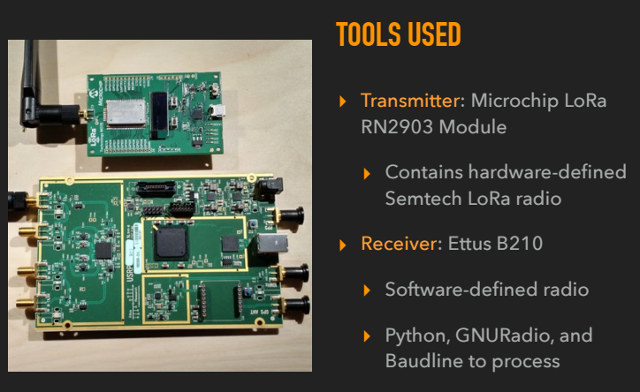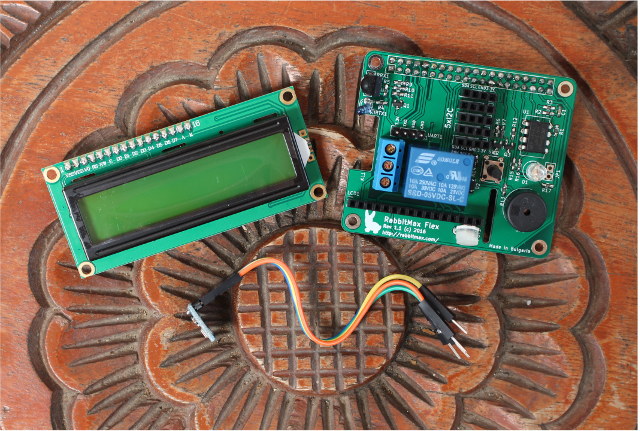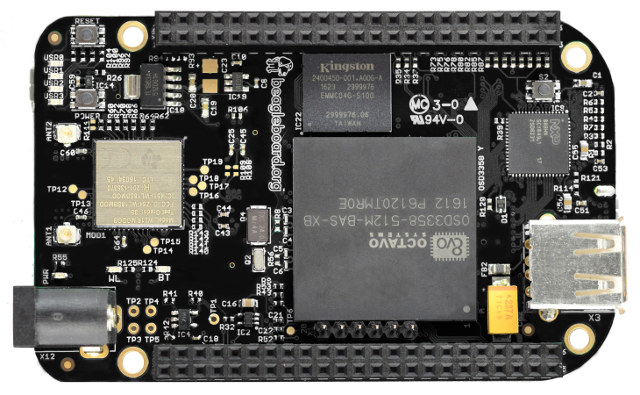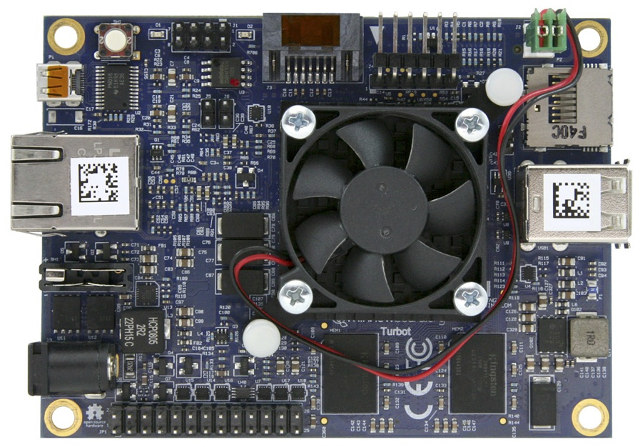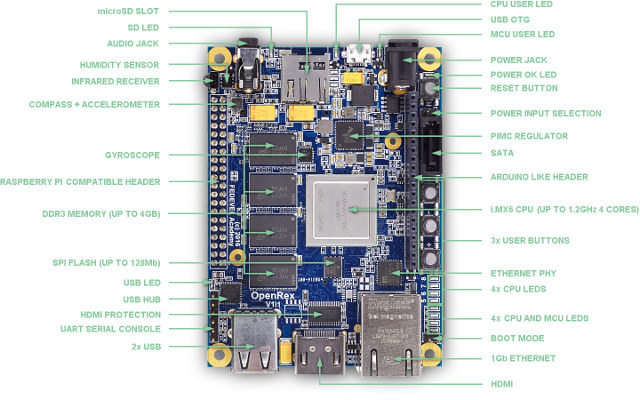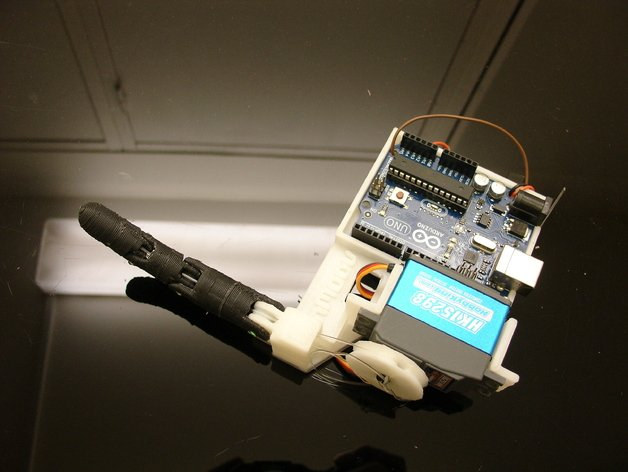Most companies specializing in development boards may sell a few accessories for their boards, but usually leave product design to their customers. Next Thing Co. does that too, but the company also produces some products like PocketCHIP portable Linux computer & retro game console, and more recently Dashbot, a voice controller assistant for your car’s dashboard powered by CHIP Pro module. Dashbot hardware specifications: CPU Module – CHIP Pro with Allwinner GR8 ARM Cortex A8 processor @ 1.0 GHz, 512MB NAND flash, 256 DDR3 RAM, 802.11 b/g/n WiFi, Bluetooth 4.2 External Storage – micro SD slot Display – Red LED display Audio – 32-bit audio DSP for beamforming & noise suppression; fairfield audio pre-processor with 24-bit ADC; high fidelity MEMS microphone array (106 dB dynamic range) USB – 1x USB host port Power Supply – 5V via USB port or 12V via power port (aka cigarette lighter) + backup LiFePo4 […]
GR-LoRa is a Reverse-Engineered Open Source Implementation of LoRa PHY
LPWAN standards such as LoRa or Sigfox allow you to transmit data over long distance, at ultra low power (up to 10 years on a AA battery), and for free if your use your own network (P2P or gateway), or a few dollars per years if you go through a network provider. The low cost is possible since those standards rely on 900 MHz ISM bands, meaning nobody has to pay millions of dollars to the government to obtain a license fee. Matt Knight looked at LoRa, and while Level 2 and 3 of the protocol (LoRaWan) has public documentation, Level 1 (LoRa PHY) is proprietary and the standard is proprietary. So he decided to reverse-engineer LoRa PHY using Microchip RN2903 based LoRa Technology Mote and Ettus B210 USB software defined radio, and software packages and tools such as Python and GNU Radio to successfully deliver GR-LoRa open source “GNU Radio […]
RabbitMax Flex IoT & Home Automation Board and Kit for Raspberry Pi
RabbitMax Flex is an add-on board for the Raspberry Pi boards with 40-pin headers, namely Raspberry Pi Model A+ and B+, Raspberry Pi 2, Raspberry Pi 3 and Raspberry Pi 0, destined to be used for Internet of Things (IoT) and home automation applications thanks to 5x I2C headers, a relay, an LCD interface and more. I’ve received a small kit with RabbitMax Flex boards, a BMP180 temperature & barometric pressure I2C sensor, and a 16×2 LCD display. RabbitMax Flex specifications: Relay – Songle SRD-05VDC-SL-C supporting 125V/250VAC up to 10A, 30VDC up to 10A Storage – EEPROM with some system information for identification IR – IR LED, IR receiver Misc – Buzzer, Button, RGB LED Expansion Header for LCD character display + potentiometer for backlight adjustment 5x 4-pin headers for I2C sensors Dimensions – Raspberry Pi HAT compliant The assembly of the kit is child’s play as you don’t even need […]
BeagleBone Black Wireless Board Gets WiFi and Bluetooth 4.1 LE, Drops Ethernet
The BeagleBone Black is still one of the most popular development boards around, but in a world going more and more wireless, it only comes with a wired Ethernet interface. Seeed Studio BeagleBone Green Wireless and Neuromeka BeagleBone Air already provided BeagleBone compatible boards with WiFi and Bluetooth LE, as well as Zigbee for the latter, but now BeagleBoard.org themselves have launched BeagleBone Black Wireless with WiFi and Bluetooth 4.1 LE based on Octavo Systems OSD3358 System-in-Package with Texas Instrument Sitara AM3358 processor, 512 MB RAM, TI LDO and PMIC, and many passive components. BeagleBone Black Wireless specifications: SoC – Texas Instruments Sitara AM3358 Cortex A8 @ 1 GHz with PowerVR SGX530 GPU System Memory – 512 MB DDR3L Storage – 4GB eMMC flash + micro SD slot USB – 1x mini USB client port for power & communication, 1x USB host port Connectivity – 802.11 b/g/n WiFi + Bluetooth […]
MinnowBoard Turbot SBC Gets a Quad Core Atom E3845 Processor, Better Ethernet, and a Fansink
MinnowBoard Turbot open source hardware SBC was released in 2015 with an Intel Atom E3826 dual core Bay Trail-I processor, 2GB RAM, SATA and Gigabit Ethernet support, and a new version – MinnowBoard Turbot Quad – with a more powerful quad core processor, an heatsink and fan, and better Ethernet connectivity will be launched in December. MinnowBoard Turbot Quad “MBT-4210” board specifications: SoC – Intel Atom E3845 quad core Bay Trail-I processor @ 1.92 GHz with Intel HD graphics @ 542 / 792 MHz (10W TDP) System Memory – 2GB DDR3L 1067 MT/s (Soldered) Storage – 1x SATA2 3Gbs, 1x micro SD card slot, , 8 MB SPI Flash for firmware (Tianocore UEFI, Coreboot, SeaBIOS) Video & Audio Output – 1x micro HDMI connector Connectivity – 10/100/1000M Ethernet RJ-45 connector (Intel i211 instead of Realtek NIC on first board) USB – 1x USB 3.0 host, 1x USB 2.0 host Debugging […]
OpenRex Open Source Hardware NXP i.MX6 Board Launched for 199 Euros and Up
OpenRex is an open source hardware board powered by NXP i.MX6 Cortex A9 processor designed by Fedevel for their hardware design course, and manufactured by Voipac, both companies based on Slovakia. The schematics, PCB layout, gerber files and other manufacturing files were released in February, but the company has only started selling the board a few days ago with OpenRex Basic SBC and OpenRex Max SBC boards. OpenRex Basic and Max boards specifications: SoC OpenRex Basic – NXP i.MX 6Solo single core Cortex A9 processor @ 1 GHz with 2D and 3D GPU OpenRex Max – NXP i.MX 6Quad quad core Cortex A9 processor @ 1 GHz with 2D and 3D GPU MCU – NXP LPC1345FHN33 ARM Cortex-M3 micro-controller @ 72 MHz System Memory Basic – 512 MB DDR3-1066 (400MHz) Max – 2GB DDR3-1066 (533 MHz) Storage Basic – micro SD slot, 1x 2Kbit I2C EEPROM, 1x 32Mbit SPI flash Max […]
C.H.I.P Board and Allwinner A13/R8 SoCs To Get VPU Support in Linux Mainline
Allwinner has mixed relationships with open source communities such as Kodi, especially due to issues with its closed-source CedarX VPU drivers, and some GPL violations. However to address the former, linux-sunxi community has been working on open source Cedrus library for the video processor unit on Allwinner processors, that’s been successfully tested on boards such as Orange Pi One. Free Electrons has gone further, as they’ve made sure Cedrus now works with Linux mainline kernel, currently Linux 4.8, and tested it on Allwinner R8 based Pocket CHIP. The work has been done by Florent Revest, a 19 years old intern at the company, who delivered a new sunxi-cedrus driver, a Video4Linux (V4L2) memory-to-memory decoder kernel driver, and corresponding VA-API backend, with the implementations currently available on Github here and there respectively. Currently only MPEG2 and MPEG4 are working, but adding other codecs such as H.264, and video encoding is possible […]
Learn the Basics of Humanoid Robots with InMoov Finger Starter Kit
In a not so distant future, most humans will live off their government provided basic income, relaxing and drinking their robot brewed, drone delivered beer or soda, opened and served by their humanoid robot maid. Well, maybe… In the meantime, it might be interesting to learn how to make humanoid robots such as InMoov, but since it’s quite complicated, it might be better to start small… with a single finger. That’s exactly what InMoov Finger Starter Kit offers you to do in order to understand the basics principles of the complete robot. The kit includes: 1x 3D printed base support in ABS 3D printed finger parts in ABS 1 meter braided 200 LB tendon 1x 5cm filament for peg/pin use to assemble finger joints 1x wheel horn adapter (Servo Pulley) 4x screws to fix the servo to the base support. You’ll also need to provide your own Arduino Uno (or […]



